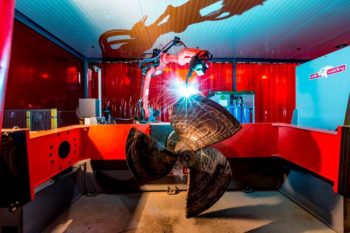
By Jite Eriabie
Dutch Damen Shipyards Group has presented today its 3D printed ship’s propeller, the WAAMpeller, following a rigorous testing process, verified by Bureau Veritas.
This project is the result of a close collaboration between RAMLAB, Promarin, Autodesk, Bureau Veritas and Damen launched seven months ago.
Promarin provided the design of the triple-blade propeller. The Port of Rotterdam’s RAMLAB (Rotterdam Additive Manufacturing LAB) carried out fabrication using Wire Arc Additive Manufacturing (WAAM) techniques, supported by Autodesk’s expertise in software, robotics and additive manufacturing.
Damen provided research and development resources in addition to one of its Stan Tug 1606 vessels for operational testing purposes. Bureau Veritas’ role was to verify the entire development, production and testing process.
The consortium reached its first milestone in August with the completion of the first WAAMpeller prototype. With valuable experience gained, production of the second version, with the aim of achieving class certification, started immediately, Damen explained.
“Production of the second WAAMpeller was greatly improved because we had learned a lot from producing the prototype,” says Vincent Wegener, Managing Director RAMLAB. “This mainly concerned the hardware/software interaction because, when laying down 298 layers of Nickel Aluminium Bronze alloy, it is important to have a tight control on all process parameters.”
With the second WAAMpeller complete, the project then progressed to the testing stage, the first phase of which saw the WAAMpeller installed on a Damen Stan Tug 1606.
“This particular vessel is of extra interest in that it is equipped with a Tier III compliant engine, making it future proof for the ever stricter environmental rules and regulations in harbours around the world,” comments Martin de Bruijn, Managing Director Workboats at Damen.
Damen’s testing engineers performed operational testing of the WAAMpeller on November 20, with representatives from all of the consortium partners present. Furthermore, the day’s procedures were overseen by Bureau Veritas surveyors throughout.
According to Martijn Nieuwenhuijs, Chief Executive of Bureau Veritas Marine & Offshore Netherlands, some challenges needed to be tackled along the way, but the final product is technically sound and ready for commercial application.
The testing programme included bollard pull and crash stop testing in addition to speed trials.
“We are pleased to report that the WAAMpeller displayed the same behaviour as a conventional casted propeller in all of the tests. This includes the same level of performance in the crash stop scenario, which – going from full throttle ahead to full throttle reverse – is the heaviest loading that a propeller can experience.
“From day one, this project has been characterized by a good working atmosphere and team dynamics, so there were quite a few high-fives on board when we had successfully completed the tests,” Kees Custers, Damen Project Engineer R&D said.
“This project has shown the shipbuilding industry the potential of 3D printing techniques for the production of vessel components. We continue our intensive research into this very exciting area,” Allard Castelein, CEO Port of Rotterdam said talking before the WAAMpeller unveiling.